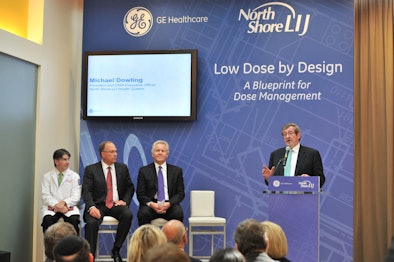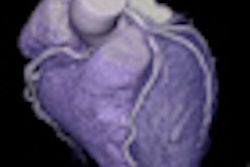
GE Healthcare launched its Blueprint program, a new service intended to help institutions and health systems lower CT radiation dose via customized dose-reduction plans, at a Thursday press conference at North Shore-Long Island Jewish Health System (NS-LIJ) in Lake Success, NY.
The health system is one of the first to participate in Blueprint, which is designed to help healthcare providers integrate CT technologies, staff education, and process improvements to successfully implement low-dose imaging, according to GE. The program is administered by a team of GE "low-dose architects," who will help customers develop system-specific, end-to-end dose management programs.
"GE Healthcare has invested about $800 million over the past decade in the area of CT dose to enable innovations from new hardware and image reconstruction, and improved exam protocols and patient planning can change the efficacy of the modality," said Jeffrey Immelt, GE chairman and CEO. "We hope to be able to cut CT dose by 50% within the next few years."
Immelt and Michael Dowling, NS-LIJ's president and CEO, discussed GE's Blueprint for low dose and the health system's specific dose reduction plan at the Center for Advanced Medicine, one of the healthcare enterprise's 260 ambulatory care centers on Long Island.
 |
| Michael Dowling, NS-LIJ's president and CEO, discusses the health system's CT dose-reduction plan during a Thursday press conference. From left, Dr. John Pellerito, NS-LIJ chief of CT imaging; Steve Gray, GE vice president and general manager for CT; and Jeffrey Immelt, GE chairman and CEO, look on. Image courtesy of GE. |
Key aspects of the Blueprint program will include GE's adaptive statistical iterative reconstruction (ASIR) low-dose technology, which is being used on more than 1,200 CT systems and more than 12 million patient exams to date worldwide. GE also hopes that its new Veo low-dose reconstruction algorithm will have the same impact.
During a presentation on Veo at the press conference, Steve Gray, GE vice president and general manager for CT, displayed images from an abdominal exam that had been performed using 0.7 mSv of radiation, the level that a person would normally be exposed to from background radiation over 90 days.
"With this new technology, profoundly clear chest CT images can be acquired with less than 1 millisievert of radiation dose," Gray said.
NS-LIJ over the next 12 months plans to purchase 16 of GE's new low-dose CT scanners equipped with Veo and ASIR, Gemstone detectors, and dual-energy spectral imaging capability. The new modalities will replace all of NS-LIJ's CT scanners, both for inpatient and outpatient imaging, Dowling said. NS-LIJ is also implementing DoseWatch, a management tool that helps providers measure, track, and optimize patient dose over time.
The new acquisitions are part of the final year of a three-year initiative by the health system to replace or upgrade more than $50 million in diagnostic imaging equipment in the imaging departments of this hospital enterprise, Dowling said.
Dr. John Pellerito, the organization's chief of CT imaging and associate chairman of its radiology department, said that collaborating with GE to provide feedback on the new products is an extension of the system's comprehensive campaign to reduce radiation dose for its patients.
"We are in full compliance with the Image Wisely and Image Gently programs, and have incorporated low-dose protocols across the system," Pellerito said during the press conference. "This includes selecting alternative exam protocols, such as using ultrasound and MRI systems that don't require radiation, when they are clinically appropriate."




















